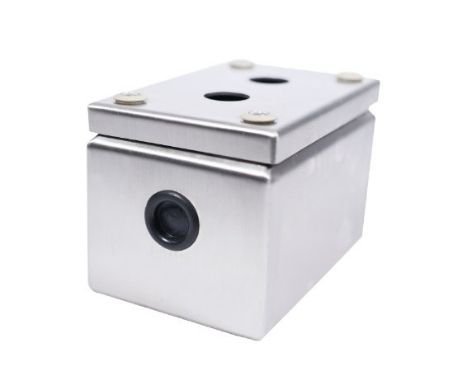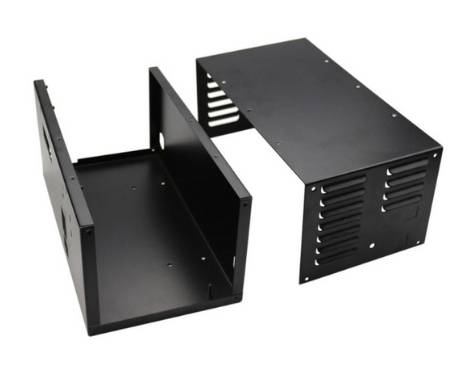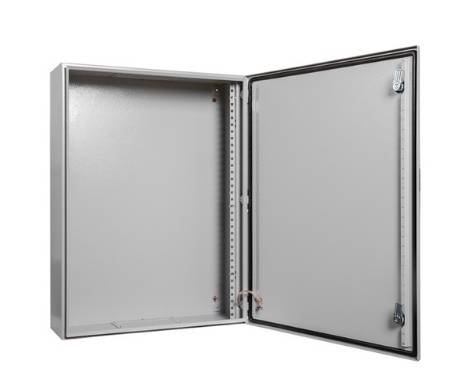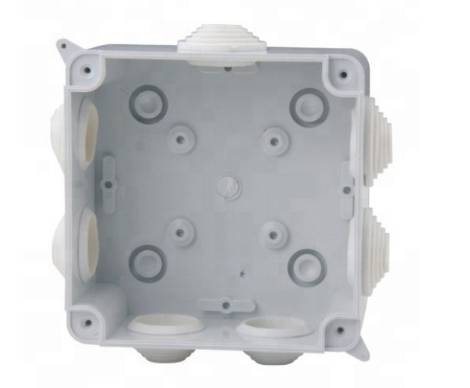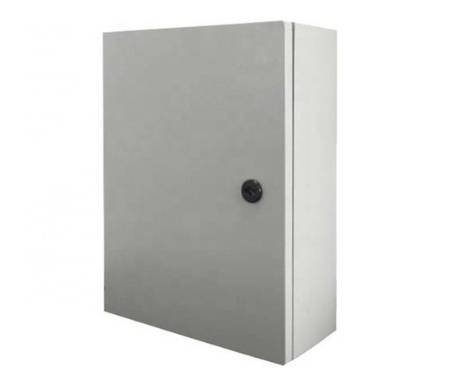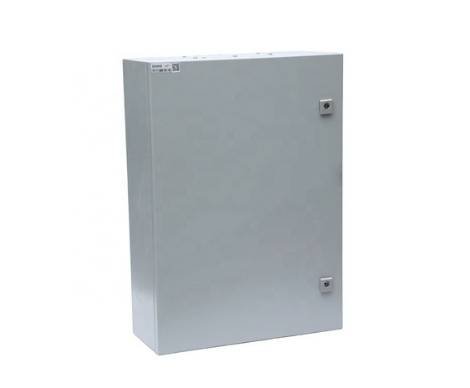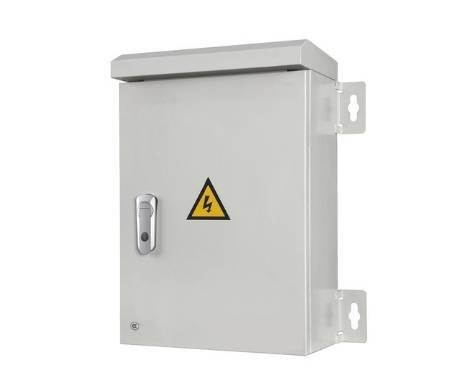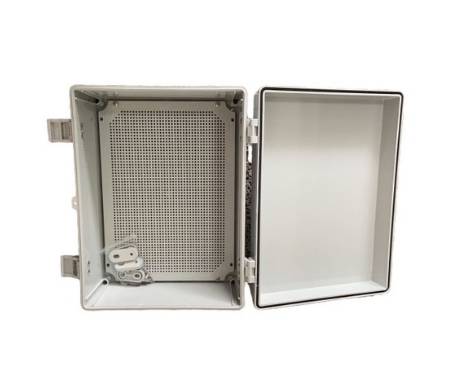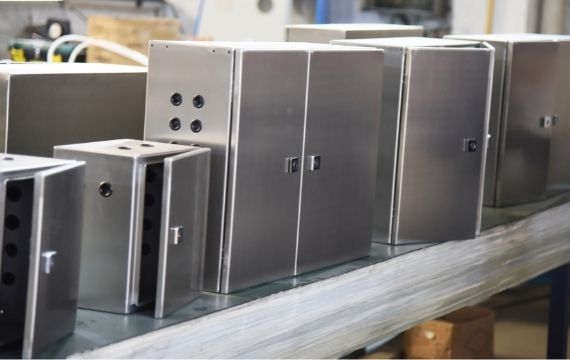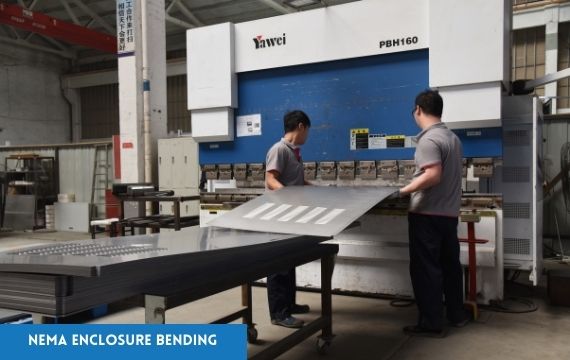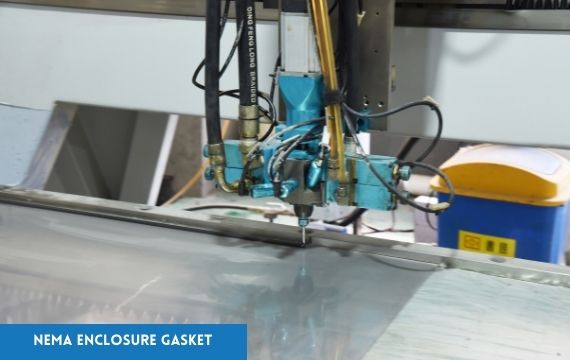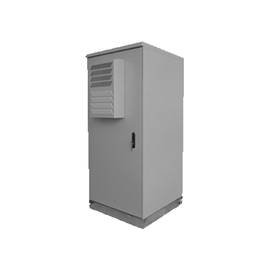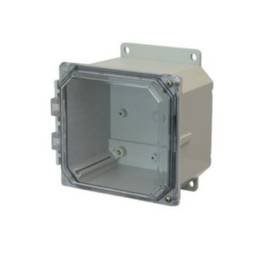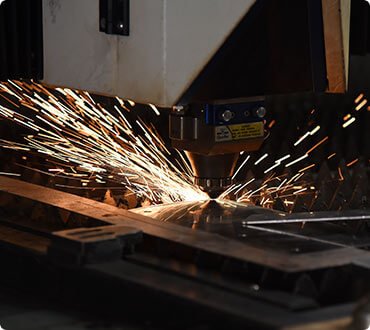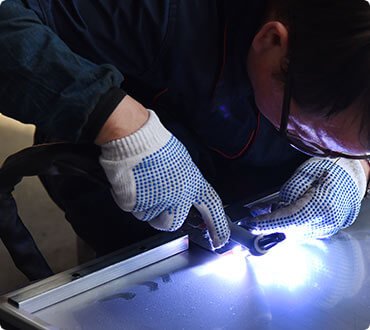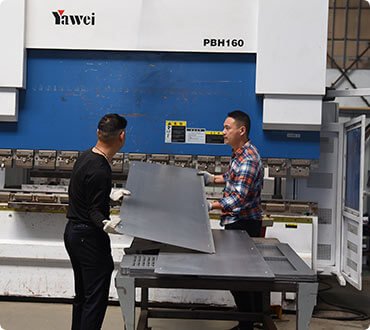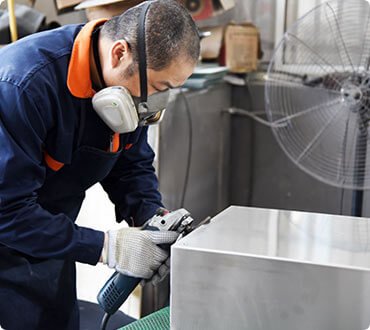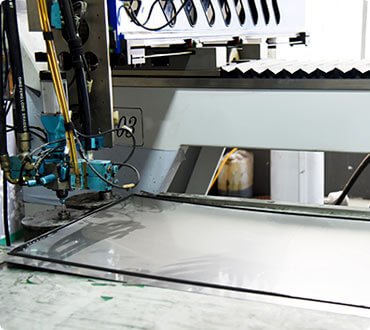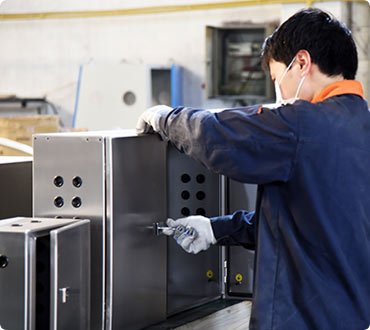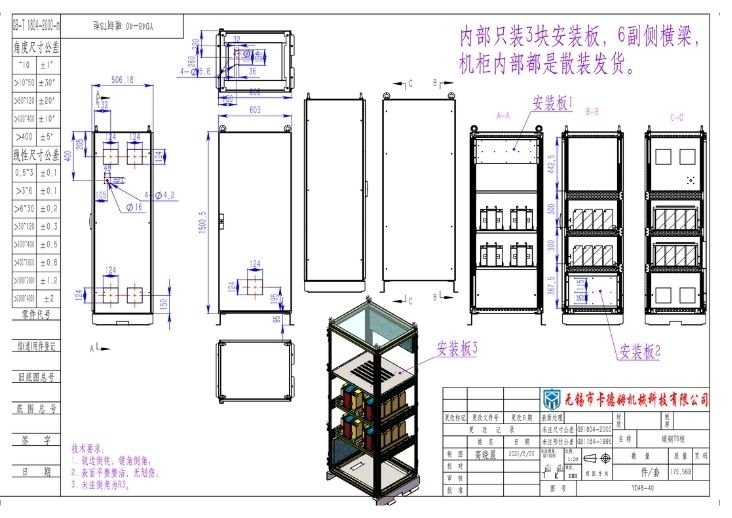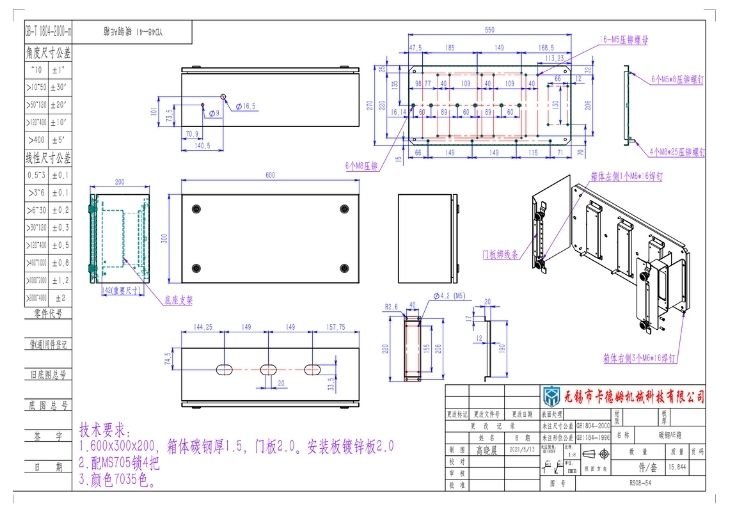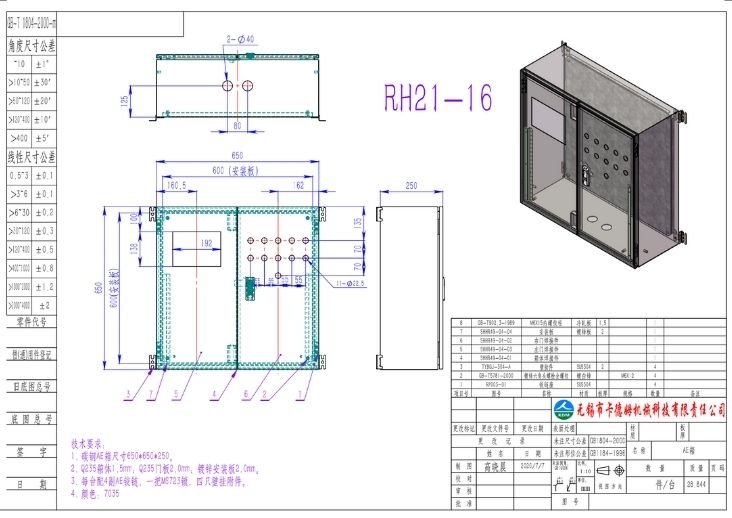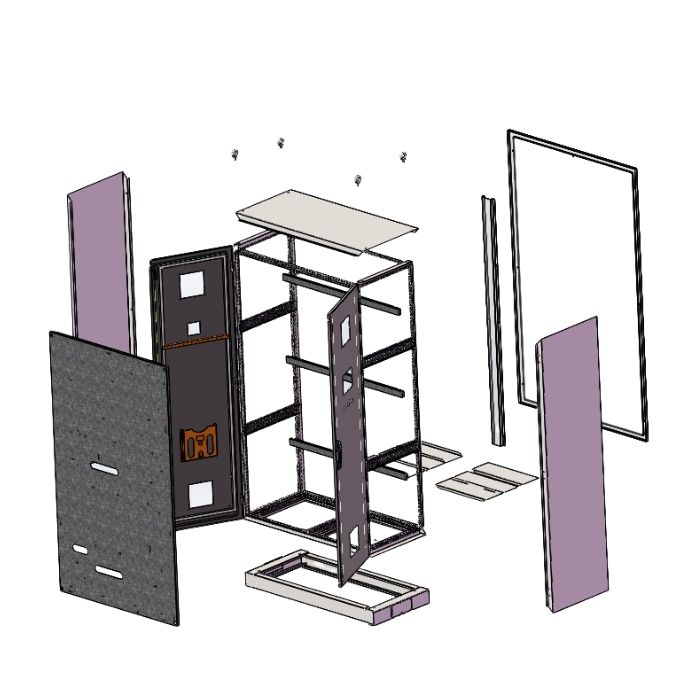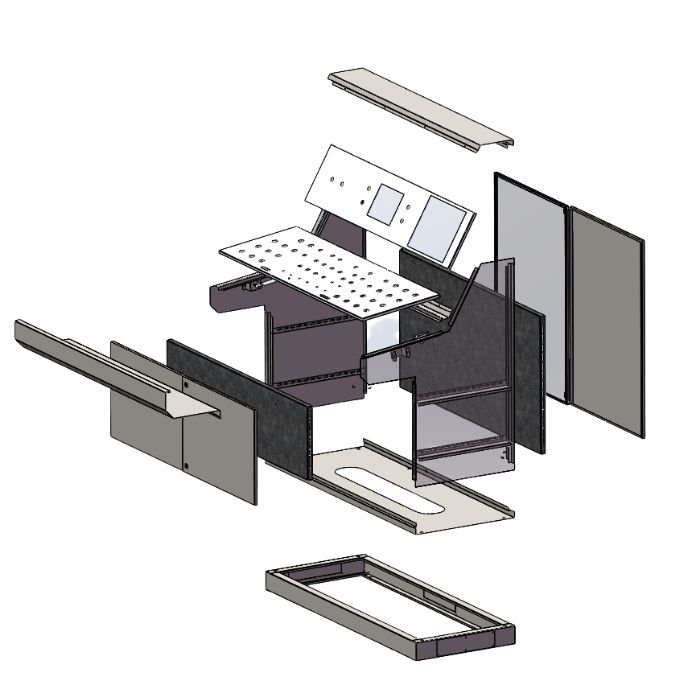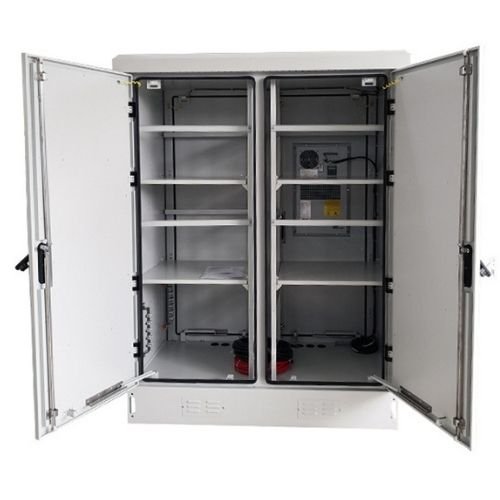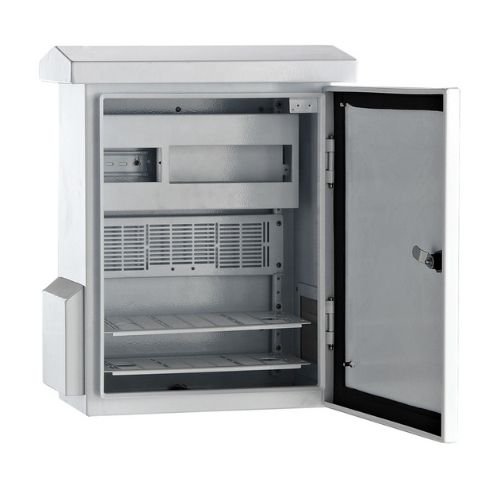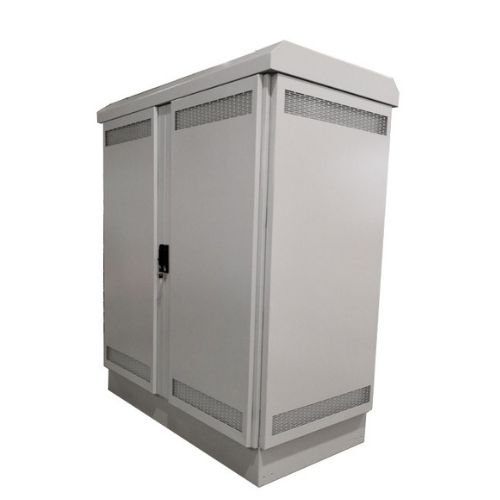您的首要电气外壳供应商
KDM 电气外壳由钢、不锈钢(包括 201 不锈钢、304 不锈钢和 316 不锈钢)和镀锌钢制成。作为专业的电气外壳制造商,KDM 可以根据您的详细要求提供任何类型的定制金属电气外壳。KDM 电气外壳非常适合保护您的组件和电线免受不同天气条件的影响,例如雨水、灰尘、污垢、油污等。您只需向我们发送您的图纸,KDM 就会为您制作完美的外壳或盒子。
电器外壳按材质分类 (6)
电气外壳按功能分类 (6)
KDM 电气外壳特点
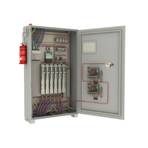
电气外壳符合不同等级的特定标准。它符合不同的保护标准,例如防雨/防腐蚀和防浸水保护。
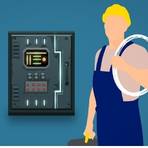
电气外壳的主要功能是为工人和设备提供安全保障。它可以保护设备免受电弧闪光等危害。它还具有接入口和观察窗等安全设计。
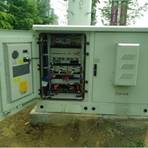
如果有效管理机柜的加热和冷却负荷,则可以保护机柜内的控制装置和电子设备。从而降低能耗。气候控制机柜的选项包括机柜加热器、热交换器等。
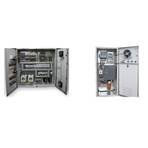
KDM 电气外壳可支撑超过 3000 磅的重量,且无需厚皮和全焊接结构的成本。
电气外壳及机柜解决方案
KDM 电气外壳精度:整体橱柜尺寸公差为+/- 1mm
标准配置: 密封板、散热风扇、荧光灯、灯开关、接地连接、PU 泡沫密封件。
保修单:KDM 电气外壳保修 1 年,您将在保修期内获得免费配件
先进的电气外壳制造
KDM 拥有先进的设备来生产一流的外壳。4000W 激光切割机可以实现 +/-0.05mm 的公差。
它们以强大的力量切割钢板,因此切割区域不会留下毛刺或痕迹。德国多功能柔性焊接设备使我们能够以相同的标准焊接所有外壳而不会变形。
您的 NEMA 外壳的定制选项
KDM 可以定制您的外壳以适应不同的应用。我们为不同的环境应用提供不同的外壳材料。我们还提供各种配件选项,例如 DIN 导轨、屋顶天篷、胶木板等。
我们可以安装带有标准电气部件(如通风风扇、照明灯等)的外壳。详情请咨询我们。
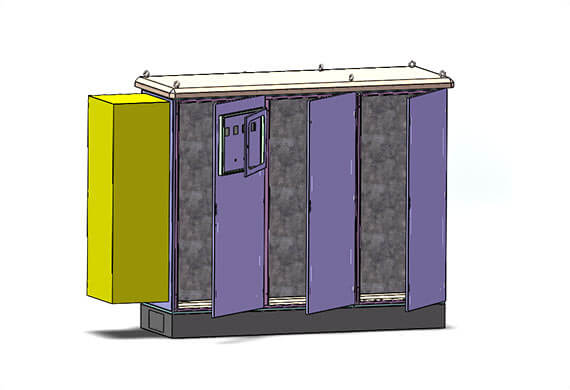
符合 NEMA 标准的电气外壳
1 型 NEMA 电气外壳称为通用电气外壳。它通常用于容纳室内电器和设备。这些电气外壳主要用于防止接触设备的带电部件,从而避免触电。
除此之外,1 型 NEMA 电气外壳的构造可保护设备免受水溅、灰尘、污垢和其他异物的侵害。
3R 型 NEMA 电气外壳适用于室外和室内电气设备。其设计旨在保护设备免受冰雪和雨水的侵袭。
这种设备大多具有底部和侧面敲除功能。因此,在特定条件下,可防止水接触设备的带电部件或干扰操作。它还可以通过防止接触带电部件来保护用户免于触电。
用途广泛的电气外壳

为什么 KDM 受到 1000 多家全球客户的信任
- 外壳制造
- 2D 绘图
- 3D 绘图
- 购买指南
电气外壳:进口商完整指南

如果您正在寻找电气外壳,那么本文适合您。
原因?
我将带您了解有关电气外壳的每个重要方面。
从电气外壳设计、材料、安全标准、安装等——您将在这里学到一切。
猜猜看,读完本指南后,您将成为电气外壳方面的专家。
什么是电气外壳?
广义上讲,电器外壳是指电气和电子元件和设备的外壳。
它看起来有点像柜子,有门可以锁上,以确保安全并防止未经授权的人员干扰。

不同类型的电气外壳
该设备允许安装旋钮、开关以及显示器等物品。
嗯,这个工具的主要目的是保护电气和电子部件。
再次,它有助于保护个人免于接触这些可能有危险的组件。
首先,该设备可以防止您或任何其他人遭受触电或爆炸。
它还可以用于保护电器免受可能引发意外触电的环境因素的影响。
有趣的是,用户只能看到电气外壳。
大多数情况下,该单位的设计总是为了满足功利原因。
但在某些情况下,它可以被设计得更吸引眼球。
尽管如此,法规可能在某种程度上决定了这些外壳的具体属性和性能。
例如,在煤矿、石化厂等被视为高风险的地区。
但最重要的是,有几个因素往往会决定这些外壳的包装。
顺便说一句,我们将在本指南的后面讨论更多此类问题。
因此请确保你读到了最后一段。
不过,现在我们先来看一下您可能会时不时遇到的一些常见设备类型。
电气外壳的优点
我们都知道,电器会产生热量,从而升高周围的温度。
但为了提高效率,必须确保找到有效的方法来维持仪器的理想温度。
所以,电笼从各方面来说都有很多好处。
由于这些都是您在不同环境中经常见到的设备,请试想象一下没有它们的生活。
这样,您就能了解这些设备的优点。

电气箱
显然,它在各个方面都可能是可怕的、混乱的、危险的和危及生命的。
电气外壳的一些优点包括:
§ 提高员工安全
正如您稍后将在本指南中发现的那样,几乎所有电气笼的应用都围绕着人的参与。
我主要想说的是,在大多数电气外壳的用途中,人们总是处于其周围环境中。
因此,保障在工厂内外执行各种任务的个人生命和福祉至关重要。
使用电气外壳可以保证在这些物品附近工作的员工的安全。
通常,这个笼子里的设备有时会产生多余的热量,这往往会让周围的人感到不舒服。
当工人接触任何裸露的电气元件时,他们还可能会遭受电烧伤和触电。
在最坏的情况下,他们可能会因严重触电而死亡。
但电气外壳可以防止此类事故的发生。
这也是理想的,因为如果员工对您提起工伤诉讼,它可以防止您支付可避免的巨额赔偿。
§ 提高设备安全性
通常,大多数电器都会产生热量。
如果不找到去除热量的方法,这种热量会严重损坏设备。
例如,它可能导致绝缘损坏、整个系统故障,甚至在某些情况下导致特定组件故障。
所以一般来说,当您使用电气外壳时,您可以降低设备散发的热量的温度。
不过,就同一主题而言,这些外壳可防止设备受到化学物质、水和灰尘等环境因素的影响。
实际情况是,在很多情况下,电器在公开暴露时就会有与这些元素接触的风险。
因此,笼子可以帮助它们远离这些因素,从而在很大程度上保护它们。
这是至关重要的,因为它在很大程度上有助于提高设备的耐用性。
因此,它可以防止您进行不必要的维修或在某些情况下更换。
正如您所知,安全的设备可以提高效率,从而提高整体生产力。
§ 降低火灾风险
过热的电气设备很容易爆炸或引起火灾。
当绝缘层损坏时,更容易发生短路,从而再次导致火灾。
设备产生的高温也会增加易燃元素引起爆炸的可能性。
如果有易燃气体或蒸汽,设备产生的热量也可能会增加自燃的可能性。
顺便说一句,您可以防止所有这些情况的发生,特别是如果您可以将所有电气设备置于受控环境中。
这就是为什么将所有此类设备安装在电气外壳内以防止发生这种情况至关重要。
§ 操作简便
您会看到,电气笼通常提供一个用于连接所有电气设备的中心位置。
这在相对较大的行业或应用中尤其重要。
从根本上来说,所有这些连接的同步都发生在这个中心点,从而让您可以轻松操作机器。
这使得整个生产过程在很大程度上变得相当简单、系统和实用。
您不一定需要用特定设备来修理整个装置的电气系统。
§ 吸引眼球
是的,这是一个优点!
电气外壳的设计结构为其所在区域增添了适当的吸引力。
事实上,即使是这个柜子里面的电器设备的排列也令人难以置信,井然有序,并保持了视觉吸引力。
这与将所有电缆和开关散落在工厂或办公室各处不同。
因此你会意识到这些笼子也有助于改善周围环境的整体外观。
电气外壳的类型
不同的项目需要各种各样的电气外壳,从小型壁挂式到步入式建筑。
因此,通常意味着您可能需要根据应用程序的类型和大小使用特定类型的橱柜。
同样,应用程序也决定了您将使用的电气笼的类型。
我知道做出正确的选择可能会有点忙乱,特别是当您不确定您需要的确切选择时。
但为了方便您,让我解释一下您的特定项目可能需要的所有主要类型;
1. 落地式电气柜
它是最流行的电气柜形式之一。
这种外壳是完全密封的,通常有支腿,通常设计放在相对平坦的地板上。
此落地式配电笼的腿部将其抬高相对较高,以方便进出。
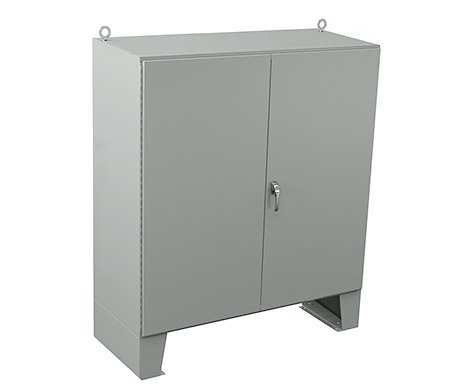
落地式电气柜
这款机柜的另一个基本特点是易于安装。事实上,支架使安装变得简单,从而降低了影响机柜可靠性的可能性。
在某些情况下,您可能会发现其他落地式电气外壳配有可选脚轮。
因此,添加这些脚轮可让您移动橱柜,无论如何,您都希望将其重新定位到特定位置。
大多数此类电气笼都是由优质材料制成,以增强耐用性。
此外,它们有不同的形式,但您也可以获得适合您特定需求的定制设计。
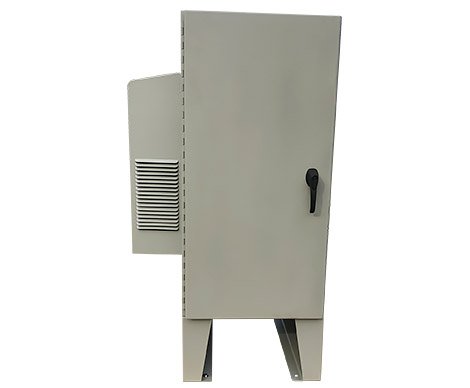
落地式电气柜侧视图
而且它们还有不同的尺寸。因此,您可以根据要安装的组件数量找到合适的尺寸。
在许多情况下,落地式电气外壳在各种工业和大型应用中很常见。
2. 壁挂式电气外壳
这是指一类电气柜,常用于容纳开关设备、仪器仪表等电气设备。
它有各种现成的尺寸,但您也可以从可靠的制造商处获得定制尺寸。

壁挂式电气外壳
壁挂式电气笼有多种不同的类型。
包括单门、双门和单双门一体式。
理想情况下,也可以使用不同类型的材料来制造这种电气外壳盒。
此外,此类电气柜的具体应用取决于材料的选择。
例如,您可以选择在相对危险和恶劣的环境中采用不锈钢电气外壳。
从根本上来说,壁挂式外壳的设计是为了附着在平坦的墙壁表面上。
3. 模块化电气外壳
这种类型的外壳通常设计用于容纳电气设备或自动化设备。
您可以根据一些因素和偏好将它们放置在不同的位置,例如背对背、并排或并排。
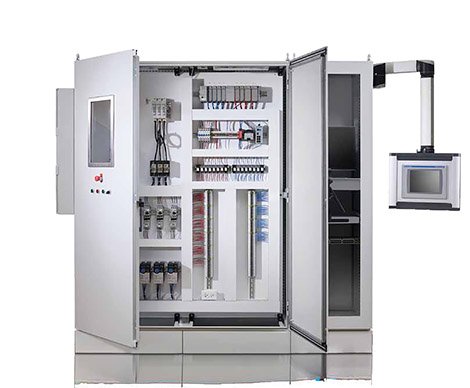
模块化电气外壳
如今,大多数制造商都可以以预组装、套件形式或根据要求提供该装置。
这至关重要,因为它可以根据任务意图使您的工作变得容易。
模块化电气外壳采用镀锌结构,非常适合减少电磁干扰。
此外,您还可以获得满足您的应用程序需求和其他元素(包括颜色和尺寸)的特定配置。
一般来说,模块化电气外壳非常适合承受高级负载和恶劣环境应用。
同时,它更易于使用并且填充速度更快。
4. 接线盒外壳
这种类型的外壳在各种小规模应用中也很受欢迎。
该装置的设计和构造是使其在市场上占据优势的一些重要因素之一。
首先,该设计采用耐用且经济的连续铰链,可提供相对平稳的最大轴向旋转。

接线盒电气外壳
这种设计至关重要,因为它可以轻松访问内部设备
此外,它还有一个完全可拆卸的夹盖式门。
而且它的优点是防水、耐腐蚀。
该装置具有多种尺寸和款式,这意味着您可以轻松找到适合您需求的装置。
此外,您还可以获得定制设计。
5. 玻璃钢电气外壳
玻璃钢电气外壳在路边很常见,通常用于存放路灯电气元件。
但是,您也可以在其他工业应用以及住宅用途中找到它们。
它们有两种主要设计,配有单门或双门以及锁定机制,以满足您的需求。
根据您的喜好和需求,有些还配有强制或自然通风。
6. 垫式安装外壳
也称为地面安装箱,指的是底部开放且通常安装在混凝土垫上的电气柜。
您会发现,安装这种类型的外壳时,需要添加开槽孔。
本质是安装固定在垫块上的地脚螺栓,以锁住箱子。
如果您正在寻找一种用于户外应用的材料,那么理想的材料就是不锈钢。
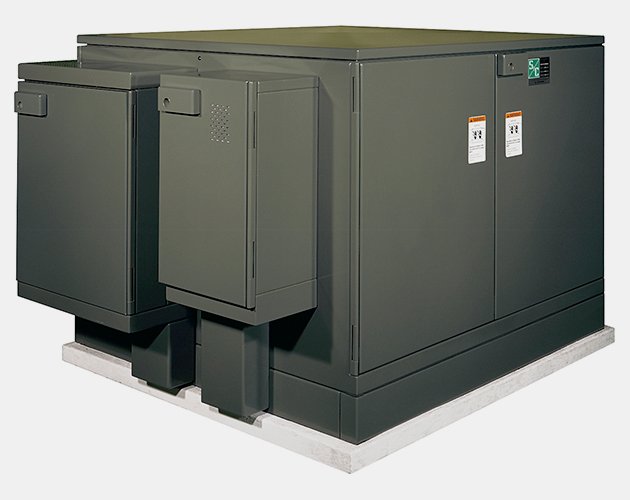
垫式安装电气外壳
如果您需要将其用于室内,您可以选择其他材料,只要它们能够抵抗各种条件。
它们适用于多种用途,包括交通管制、电信、街道照明和太阳能电池等。
然而,由于安装的性质,您很少能以大尺寸使用它们,这有时会带来不利影响。
7. 交通控制围栏
顾名思义,这是指用于容纳与道路交通管制相关的各种设备的电气柜。
它安装在道路沿线的各个位置以及不时有交通的空间。
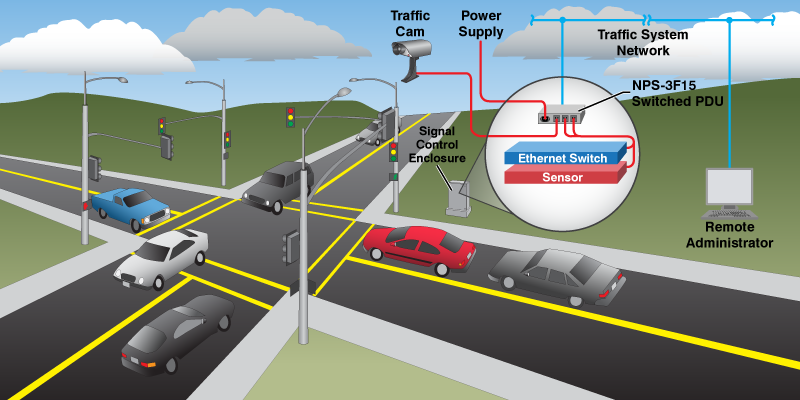
交通控制围栏——图片来源:Western Telematic
您可以找到各种材质的,但在大多数情况下,由于安装环境的性质,它们都采用不锈钢材质。
关于这些类型围栏的一个重要方面是它们往往因城市或城镇而异。
主要是因为每个城市在安装交通控制箱时都有具体的考虑。
它们还具有有效的锁定系统,以增强设备免受破坏的安全性。
此外,可锁定机制还可增强其他道路使用者的安全性,防止其遭受触电和电击等。
8. 杆装电气箱
再次,正如名称所示,这种电气外壳安装在室内支撑杆、灯杆和室外电线杆上。
它们适用于多种用途,包括花园照明、街道照明和其他小型户外应用。
而且由于它们通常用于户外,这意味着获得一个由不锈钢材料制成的产品会很棒。
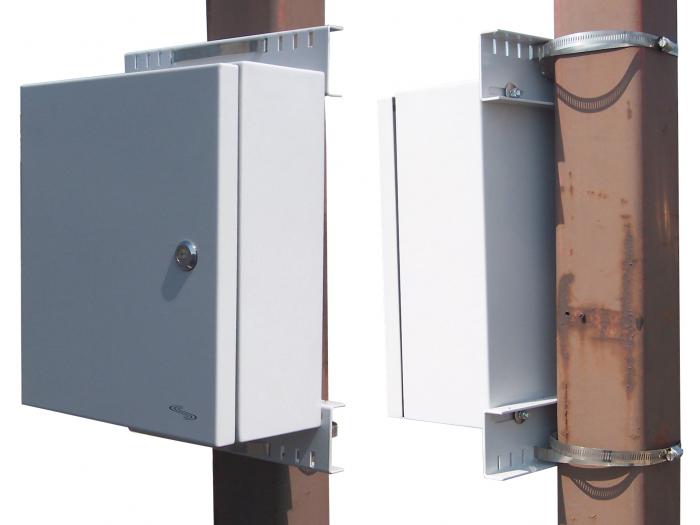
杆式安装电气外壳
或者,您可以选择任何其他您确定能够抵抗不利环境条件的材料。
但一般来说,它们总是在一些小规模的应用中很常见。
另一个重要因素是,杆式电气柜也有不同的尺寸和形状。
因此,根据您要安装的设备数量,您可以选择适合您的设备。
9. 步入式电气柜
到目前为止,您已经了解到,很明显,配电箱可以根据需要制造成各种各样的设计和尺寸。
步入式类型可以说是您在市场上能找到的此类设备的最大设计之一。
通常,该设计旨在服务于相对较大的建筑和工业。
大多数情况下,该装置的结构具有两个以上的入口门。
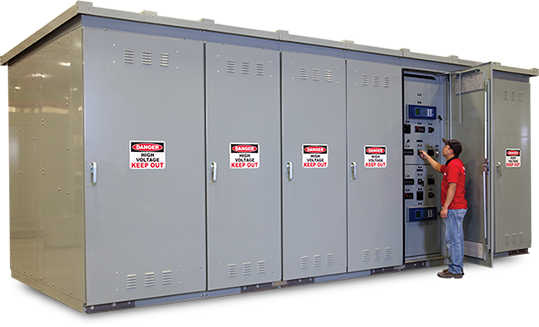
步入式电气柜
它们通常底部是敞开的,但您也可以选择配备全地板的。
此外,步入式配电箱的材料选择取决于特定的应用和周围环境。
因此,由于它们的尺寸巨大,为了提高效率,最好选择配有一些附加配件的产品。
例如,您可以选择具有吊耳的吊具,以便更容易拆卸或放置。
唯一显著的缺点是它们占用相对较大的空间,因此不适合小规模应用。
制造电气外壳的材料
顺便说一句,这是购买电气外壳时必须考虑的最重要的方面之一。
我的意思是,在很多情况下,你会发现这些橱柜采用不同类型的材质。
然而事实是,多种因素决定了制造特定类型外壳的材料选择。
例如,如果目的是用于户外安装,那么肯定意味着它必须获得一些特性才能承受环境。
然后你还必须考虑破坏行为,这显然已成为当今的一个大问题。
简而言之,在进口之前,您必须仔细选择电气笼的材料。
在这种情况下,请继续阅读以找到可供选择的替代方案的快速指南;
i. 不锈钢电气外壳
这可以说是制造电气外壳最常见的材料类型之一。
必然地,它是一种含有不同数量的铬和镍的合金。
正是这种组合加上其他元素使得这种材料几乎能够抵抗污染和腐蚀。
在许多应用中,无论是室内还是室外,这种材料都变得至关重要,因为它具有两种环境所需的所有理想特性。

不锈钢电器外壳
但事实上,这种类型的材料也有多种等级可供选择。
这是由于组成它的主要元素的比例含量不同造成的。
但市场上最常见的类型有哪些?
304 和 316 是最受欢迎的材质,尤其适合制作电气柜。
304 含有 18% 铬和 8% 镍,而 316 含有 16% 铬、10% 镍和 2% 钼。
不锈钢 比低碳钢坚硬得多,加工起来颇具挑战性。
但最棒的是,它的结构更坚固,而且导热性相对较低。
再次,您可以使用它来使这些结构处于几乎未涂层的状态,无论是在室内还是室外。
当然,这是因为它具有很强的抗腐蚀性能。
但在很多情况下,您会发现未涂层的不锈钢电器外壳是抛光的。
这样做的原因通常是为了增强其美感。
但由于其含有更昂贵的金属,因此其成本比低碳钢略高。
但是您仍然可以在许多不同的应用中舒适地使用它,特别是在腐蚀环境和沿海地区等。
ii. 碳钢电气外壳
这是许多制造商在制造这些设备时考虑使用的另一种材料。
碳钢适合制造安全等级的电气外壳。
它们非常适合腐蚀不会成为特别突出的问题的一般室内和室外应用。
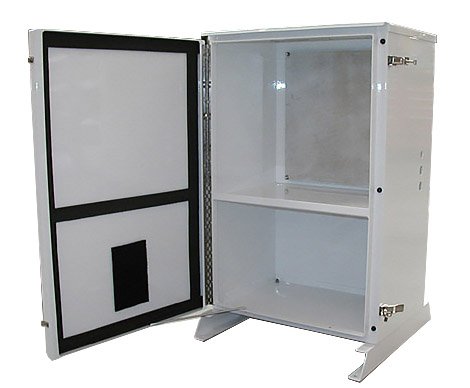
碳纤维电器外壳
由于这种材料具有相对多的优点,因此也广泛用于制作这些物品。
嗯,在某些情况下您可以将其称为锻钢。
这种材料的最佳特性之一是其高度可塑性。
那么这到底有多重要?
听着,这种延展性至关重要,因为你可以使用这种材料来形成任何形状。
通常,碳钢可以分为四大类,当然取决于碳的成分。
此类材料主要有低钢、中钢、高钢和超高钢等类别。
在这种情况下,这种材料最重要的方面是,您可以使用所有不同的类别来生产外壳。
因此它很有用,因为您可以对其进行自定义以获得最适合您特定需求的内容。
iii. 铝制电气外壳
铝还常用于制造广泛领域的各种类型的电气外壳。
这种材料通常相对较轻,但不一定像不锈钢那样坚固。
在这种情况下,这意味着如果您使用更厚的板材,它将是必不可少的。此外,铝是非磁性的。
您知道这对于电气外壳来说至关重要,因为它可以消除笼内的涡流。
这是该材料广泛用于制造电气柜的重要因素之一。
您可能不想阅读有关铝材料的文章,但我们还是来看看吧:
与不锈钢相比,它的一个缺点是易受腐蚀,因此不太受欢迎。
尽管如此,从积极的一面来看,它会迅速形成一层被称为氧化铝的白色物质。
正是这种物质将其与氧气隔绝,从而防止进一步腐蚀。
再次,您可以相当安全地将未涂层的铝用于户外应用。
但请记住,您必须进行涂漆或粉末涂层以增强美感。
可以使用这种材料的一些应用包括户外配电盘和沿海地区。
iv. 聚碳酸酯电气外壳
一个 聚碳酸酯材质 指的是含有碳酸盐基团但处于其化学状态的绝对坚固的热塑性塑料。
它实际上是制造电气外壳的最佳非金属材料之一。
值得注意的是,它具有很强的抗腐蚀和酸性环境能力,这让它可以说是最好的材料。
令人惊讶的是,塑料是具有很强的抗冲击、抗划伤和抗凹痕性能的最好的材料之一。
你看,经常发生的情况是,你可以将聚碳酸酯材料与一些涂层技术结合起来。

聚碳酸酯电器外壳
这使得它们即使在恶劣的条件下也能够发展并保持各自的特性。
聚碳酸酯的另一个优点是其非导电性质使其不再需要将接地带连接到盖子上。
然而,您会发现聚碳酸酯电气外壳在较小的应用中非常常见。
例如,本地控制站、仪表箱和编组箱等的外壳。
理想情况下,您会在市场上找到多种选择。
最重要的是选择适合您特定需求的正确类型。
您还需要注意,安装此设备的环境也是一个重要的考虑因素。
但总体来说,上述所有材料均能适当地适应室外和室内环境。
在我忘记之前,您还必须确保您选择的特定材料符合标准规格。
说到规格,让我们来讨论一下电气外壳应遵守的常见标准;
电气外壳标准
听着,电气柜的行业标准旨在促进安全和提高效率。
因此你会发现,西方世界多个国家的当局都是出于这样的原因而执行这些标准。
再次,您会发现这些单位在尺寸、材料、结构和设计方面存在很大差异,尽管它们具有共同的目标。
这些标准对于定义产品性能的最低水平也至关重要。
这就是您在购买任何类型的电气外壳时都应该特别注意的原因。让我们来看看这些设备应该遵守的一些常见标准。
§ NEMA 标准外壳
NEMA 指的是 美国电气制造商协会.
该机构制定了美国适用于不同用途的各种等级配电箱的标准。
该机构还对每个单位进行评级,以防止个人接触危险部件和其他环境条件。
通常,NEMA 外壳标准可能会根据灰尘、水、冷却剂、油等环境脆弱性进行评级。
理想情况下,您还必须意识到 NEMA 评级也可能造成很大混乱。
但他们发布的标准对用户确保兼容性安全性和正常运行有帮助。
按说, NEMA ICS 6 根据外壳防止液体、灰尘和腐蚀性物质损害的能力,对外壳进行分类。
此外,您必须知道,NEMA 定义并发布了各种电气柜的标准和制造商的合规性。
总而言之,NEMA 仅仅传达了入口进展。
此外,它还涉及结构、性能、适用性和其他相关测试。
一般来说,NEMA 基本上根据类型而不是 IP 对电气外壳进行评级。
它还允许自我遵守,这一点至关重要,因为不需要进行制造现场评估。
§ 知识产权标准
该标准也称为 国际防护或入侵防护等级.
理想情况下,它被定义为电气箱防止外来物体侵入的密封效率的程度,并符合国际标准。
一般该标准由两个前缀字母IP和两个数字组成。
这些数字本质上是机柜对固体物体提供的保护级别。
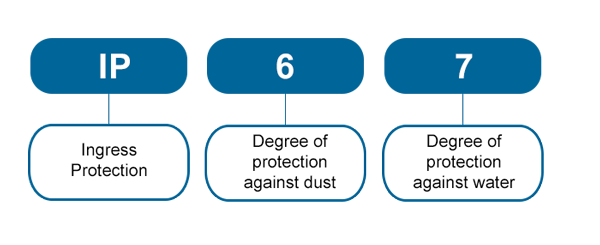
IP 等级
另一方面,第二位数字表示机柜内设备的防水等级。
由于不同的电气外壳具有不同的 IP 标准,因此您会遇到不同类型的 IP 等级。
这就是为什么您在选择适合您需求的产品时必须小心谨慎的原因。
或者,您可以选择寻求专业电工的帮助来指导您做出正确的选择。
§IEC 60529
该标准在欧洲地区很常见,用于通过不同要素来衡量外壳的性能标准。
每个 IP 等级的 IEC 额定值都规定了可进入外壳的水量。
另一方面,与 NEMA 不同,该标准并未指定针对爆炸危险的防护程度。
简而言之, IEC 60529 代码识别侵入保护的等级。
他的标准还描述了机柜保护其组件免受灰尘、湿气和人为等影响的能力。
此外,IEC 标准还允许自我测试。
但一些制造商经常考虑让独立测试机构测试他们的产品以确保合规性。
§ UL 50 和 50E
主要地,UL 的标准是基于 NEMA 的规范。
尽管如此,他们也通过第三方测试现场评估来强制执行合规性。
因此,如果您购买带有 UL 认证,这表明制造商遵守 NEMA 标准。
基本上,这些是市场上一些常规的电气外壳标准。
正如您所看到的,这些评级至关重要,特别是在确定性能和安全性时。
一般来说,标准对于任何配电箱的效率都起着重要作用。
电气外壳的组件
嗯,了解电气外壳的各部分是最重要的要素之一。
顺便说一下,由于该设备非常简单,因此零件不一定很多。

电气外壳示例
因此在这种情况下,让我们看看在处理橱柜类型时您可能会遇到的一些部分;
§ 接线盒
这些是指在多电路布线中用于将架空服务转换为地下服务的电气元件。
您将它们安装在外壳盒内,以实现保护、方便、节省时间和电线接头连接。
制造商使用不同类型的材料来制造这些设备,并且还提供各种尺寸。
从根本上来说,它们还具有理想的防护等级和广泛的环境温度范围。
§ 人机界面
这是连接到控制器的机器级和独立小型过程应用程序的接口硬件。
在电气外壳中,它可以实现高级可视化并将各种操作集成到监控级解决方案中。
事实上,它是适合需要操作员不时控制的电气柜的组件。
此外,它还增加了机器的美学价值,并为设备提供了安全性,防止未经授权的用户使用。
§ 热管理单元
这是一种监测电气箱内各种温度和冷却方法的仪器。
它通常用于控制整个机柜的整体温度以及单个 IC 的温度。
当然,您知道各种电子设备和电路的组合往往会产生过多的热量。
因此,这是一个重要的组件,因为它提供了理想的温度,以防止盒子过热。
其本质是提高电气柜的整体效率并防止任何功能故障。
§ 电缆管理
在这种情况下,电缆管理本质上是指箱子中的电缆配置。
在许多情况下,根据您使用的机柜的尺寸和设备的数量,电缆可能会缠绕在一起。
因此在大多数情况下这会使您有效地处理电缆变得相对困难。
在某些情况下,当您尝试移动或移动电缆时,可能会导致意外拔下设备。
它也至关重要,因为它使得机柜内电缆的安装和后续维护变得容易。
§ 框架

电气外壳框架
框架是指外壳的整个构造。
这取决于该特定产品的形状、尺寸和材质。
大多数情况下,框架可能会因多种因素而变化。
它主要是该产品的盖子,里面装有所有其他组件。
§ 锁
无论设计和尺寸如何,电气外壳都有入口点。
因此,这些入口点有一个锁,通常用于保护设备内部的组件。
因此,锁通常是让您保护电气柜内电气设备的一部分。
这样做的重要性在于提供必要的安全性并防止箱子内容受到干扰。
§ 接地
接地是一种低电阻电线,可将电能立即释放到大地。
这是将装置的特定部分与地球的导电表面连接起来的组件。
它通常适用于电气外壳以提供安全性和功能效率。
该组件需要接地,因为它可以保护您免受不可避免的短路电流的影响。
该部件还可以保护您和电气外壳内的组件免受雷击和高压浪涌的损害。
嗯,这些是电气柜的关键零件和组件。
但是,根据设计、尺寸和预期用途,您还可能会找到该设备的其他部件。

电气柜零部件
因此,我们最好在这里简要地看一下其中的一些
- 遮阳罩——它是保护设备免受阳光直射的部件,从而防止其产生不必要的高温。
- 屋顶——指外壳的最上部,用于遮挡设备,防止阳光、雨水或任何其他异物的影响。
- 支架——这些组件为设备提供支撑,使其相对高于地面。
- 通风口——指配电箱框架上的特定开口,有助于促进柜内空气流通。
- 窗口 – 这也是机柜框架上相对较大的开放空间,可用于接触组件。窗口还有助于在机柜内部提供足够的空气流通。
- 联轴器——这是一种用于连接两个轴的末端以传输动力的装置。
- 防滴罩——它指的是防止水或任何液体物质进入电气外壳的一种部件。
- 门撑——这是一种用于将门固定在关闭或打开位置的装置。它还有助于防止门打开得太大或关闭时门摆动。
在某些情况下,您可以将其称为门挡、门楔或门挡。
- 正面无电 – 指电气柜内不包含任何带电元件的操作侧。其本质是防止个人接触箱体的操作部分。
- 密封板 – 这是一种用于连接和固定配电箱内电缆末端的装置。它对于密封穿过隔板的电线也是必不可少的。
- 通孔——这是完全穿过电气外壳物体表面材料的孔。
必然地,这些是您可能还会遇到的配电箱的一些附加组件和零件。
但重要的是要了解,它们可以根据每个应用程序的适用性在特定的机柜上使用。
好了,既然您已经了解了这些设备的零件和组件,那么了解基本的安装过程也是必不可少的。
这就是我们进入本指南的下一个子部分的原因。让我们来看看;
如何安装电气外壳
现在,您知道电气外壳必须经过适当配置,然后安装在特定位置。
但在我们讨论该设备的安装过程之前,您必须了解一个至关重要的方面;
安装过程在很大程度上取决于应用的类型、环境和外壳的大小。

钢制电器外壳
理解这一点的重要性只是为了让您知道安装步骤可能会有一些差异。
需要此组件的项目多种多样,从最小的壁挂式安装到箱子,再到完全步入式的建筑物。
因此,获得一个能够适应任何安装配置的外壳设计非常重要。
安装该设备的一些典型应用包括墙壁、杆子、垫子、步入式和独立式等。
在这种情况下,我们想从总体上看一下将该设备安装在墙壁上。
步骤 1:识别适合外壳的零件
基本上,您首先要确保列出要安装在该笼子内的所有电气元件。
这无疑会让您了解您的应用所需的理想尺寸,无论是住宅还是商业。
在此之后,您现在可以知道您所需外壳的大致尺寸和设计,从而让您轻松购买合适的外壳。
第 2 步:获取正确的工具
理想情况下,安装电气柜需要一堆工具,当然这取决于其尺寸。
一些最明显的工具包括电钻、剥线钳、尼龙扎带、安全手套、口罩和石膏板锯。
在其他情况下,您还需要美工刀、各种螺丝刀、网络测试仪、电工剪和护目镜等。
只需确保您拥有正确的工具即可在安装此组件时提高便利性和效率。
步骤 3:标记并准备封闭区域
这实际上是您必须进行的此安装的第一个密集方面。
此时您必须非常细心,因为有带电的电线水平穿过螺柱。
如果您在这里弄乱了,那么您将危及整个安装系统。
为了安全起见,您应该使用带电线探测器来确定外壳的正确位置。
然后将所有电缆集中在一起。
然后用一把美工刀在石膏板上打一个洞。
之后,使用干墙锯切割开口。
建议先切一个小口,以便探测腔体内部的接线。
步骤 4:接通笼子的电源
通过这样做,您必须确保将低压与低压分开。
如果可能的话,请使用双插座将电压输入到电气外壳中。
同时,将所有线电压连接保持在外壳外部。
实现此目的的理想做法是让线电压低于外壳。
步骤 5:安装外壳
在执行此操作时,您必须考虑多种因素,因为这可能是无法挽回的局面。
因此首先,你必须正确处理它,因为这是整个过程的关键方面。
盒子底部有一个开口,您应该留出该开口以便于外壳接线。

将所有必要的电线拉进笼子里,并确保它们都有明显的标记。
但切勿剪断已经拉进盒子里的电线。
如果它们太长,您可以将它们推入外壳上方的空腔中。
步骤6:配置内部组件
这也是另一个基本方面,因为您需要布置外壳内部的所有组件。
本质上,这为您提供了如何将此类设备放置在外壳中的总体概念。
布局的类型和排列还取决于您要修复的组件的数量。
再次强调,外壳的尺寸决定了如何配置内部组件。
步骤 7:逐个安装内部组件
至此,您就快完成任务了。
这意味着您现在正在根据之前配置的特定布局修复所有组件。
安装这些组件时,始终确保每个位都进入相应的电线。
您绝不会犯将电缆与特定设备混淆的错误。
这可能是有风险的,因为它会让您自己和组件面临无法估量的危险。
如果需要的话,您可以寻求专家的帮助。
步骤8:完成接线过程
现在所有设备都已完好无损,您可以完成所有悬挂电缆的接线。
此时,您还需要拧紧任何松动的螺母或螺栓,以确保所有组件都固定牢固。
在此阶段,您还应使用唯一代码标记完成所有接线过程后的组件。
这很重要,因为它使您能够在以后出现问题时轻松访问特定组件进行维修或更换。
最重要的是确保使用所有标准化工具,以便在发生不幸事件时增强安全性。
嗯,正如你所看到的,这不一定是一个复杂的过程。
一旦您掌握了基本知识和正确的工具,您就可以轻松快速地完成此任务。
另请记住,安装区域可能因应用程序而异。
但安装过程大致相似。你只需要调整几个步骤。
尽管如此,您应该始终强调的最重要的因素是安全。
尽一切可能确保安装前、安装中和安装后整个过程的安全。
电气柜性能参数
事实是这样的;
电气外壳标准化的主要原因之一是保证理想的性能。
您会看到,这里有多家制造商生产多种多样的产品,而且显然承诺提供更优的性能。
然而,如果你不够敏锐或者知识不够丰富,你以后就会意识到你受到了不公平的待遇。
相信我,这些设备可能需要相当大的投资,因为其中一些设备无疑是昂贵的。
因此,您完全没有理由购买无法尽可能满足您需求的电气外壳。

带锁的钢制电气外壳
因此,您必须确保了解您想要购买的特定型号的各种性能因素。
因此,让我们来看看您需要考虑的电气外壳的一些基本性能要素;
i. 热管理
可以理解的是,热管理是指对电气外壳产生的温度的监测和调节。
毫无疑问,这是一个重要的方面,因为温度对该装置的可靠性和服务有相当大的影响。
事实上,在大多数情况下,电气箱的故障和失效总是由于热问题造成的。
那么不良的热管理是否会影响此类装置的效率?
是的,确实很糟糕,这是简短的回答。
在制造业和银行业等其他行业,一小时的停机可能会导致大量金钱的损失。
如果您希望将箱子的热活动管理到最佳状态,您必须一丝不苟并且始终做好计划。
但最重要的是要确保在外壳的内部和外部温度之间达到适当的平衡。
实现这一目标的理想方法是不时进行热分析。
在很大程度上,这个因素决定了电气外壳的性能,因此必须加以考虑。
ii. 安全和环境合规性
这是您必须考虑的作为性能决定因素的另一个基本要素。
顺便说一句,电气设备必须符合安全和环境标准。
您会看到,这种合规性是其在各种应用中的适用性和效率的保证。
因此,您绝不应该考虑不符合任何这些基本标准的电气外壳。
在这种情况下,安全意味着确保您作为主要用户的安全以及第二方和第三方用户的安全。
从环境角度来看,电气柜还应提供安全性,以免危及周围的其他财产。
首先,您会发现大多数时候有关人类和环境安全的严格规定是根本的。
相当大程度上,它们决定了盒子的整体性能。
我敢打赌,你甚至不愿意靠近任何对你的健康有一定风险的电气元件。
iii. 保护功能
决定电气外壳性能的另一个因素是其所具有的安全功能。
通常,监管机构希望所有此类设备的制造商都能够采用广泛的保护功能。
当然,在这种情况下,目的在于通过在使用该设备时提供最佳保护来提高效率。
因此,保护功能在处理和控制任何电气柜的整个过程中发挥着重要作用。
电气外壳的应用
正如您在本指南前面的部分中所看到的,很明显电气外壳可以应用于各个领域。
但是您还必须知道,有几个因素通常决定了特定应用的最佳外壳的选择。
谈到这个话题,选择偏离目标的设计或类型可能是一个危险且代价高昂的错误。
那么让我们简单了解一下该设备的一些值得注意的应用;
§ 交通管制
交通灯显然使用多种大量依赖电能的装置。
但是你看,你永远不可能公开安装交通信号灯的所有电气元件,例如开关控制。
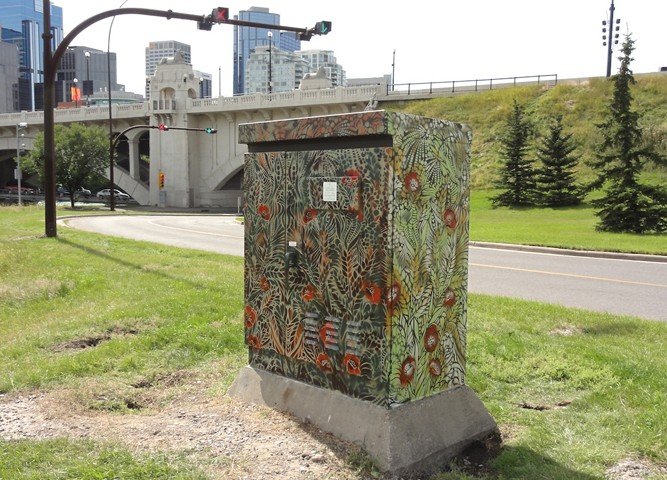
交通控制电气柜
这时交通控制围栏就派上用场了。
世界各地的不同市政和交通部门都使用外壳来存放相关设备。
请记住,交通管制是一个关键因素,必须系统地进行,以防止不必要的不便和混乱。
§ 街道照明
同样,各个国家的大多数街道都有不同类型的灯光。
显然,所有这些灯都是由一个包含所有必要电气配件的特定点进行控制的。

带电气外壳的路灯——图片来源:VORPENERGY
当然,你不可能让每盏路灯都有自己的开关或独立的连接。
因此,电气外壳对于确保电气附件限制在一个中心点变得非常重要。
§ 电信
外壳在电信领域也至关重要,因为它们可以保护传输语音、数据和视频的电气设备。
电信设备非常敏感,因此需要特别保护它们,以免受到可能导致不必要中断的因素的影响。
因此,大多数电信公司依赖定制外壳来满足其不同需求。
§ 太阳能电池
大多数情况下,太阳能电池板的电池相对较重,需要一个盒子。
正是这个盒子帮助这些户外电池达到维持其生产力的必要条件。
因此,您会发现在这种情况下外壳非常方便,因为它们可以保证电池的安全。

带电气外壳的太阳能灯 - 照片提供:REXEL ENERGY SOLUTIONS
这种箱子的设计还有利于外壳的冷却和电池释放的气体的去除。
还要记住的是,这始终是可能的,因为太阳能箱耐用且具有额外的强度。
§ 塔式支架
塔式安装座也是使用外壳盒的另一个常见领域。
通常,您会发现使用这些盒子的塔架可用于各种应用,例如风能、太阳能、卫星和无线电设备。

独立式电气外壳
它们对于确保这些设备在理想条件下能够发挥其特定作用具有重要意义。
§ 食品和饮料
许多食品和饮料制造商也使用电气柜来存放其机器的电气设备。
听着,在任何一家普通的食品和饮料公司,你都会发现各种设备在整个过程中发挥着不同的作用。

PLC 电气外壳
例如,您会发现电锅炉、烘干机和升降柱机等。
因此,所有适当的电气控制系统都必须集中在一个安全的地方。
这就是电气外壳变得至关重要的原因。
§ 信息技术和服务器
这也是电气外壳应用最为突出的其他领域。
通常,您会发现它们在这个领域有不同的配置,因为它们必须符合工业标准。
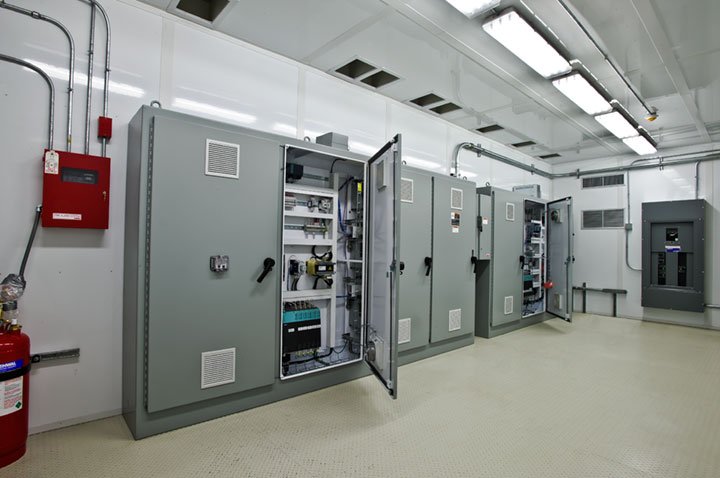
服务器电气外壳
实际情况是,不同的应用程序使用不同类型的服务器机架和机柜。
但最重要的是,它们对于确保服务器的所有关键元素都被安全隐藏至关重要。
§ 电缆/电线管理
如果您去过批量生产各种工业产品的公司,您一定会注意到多根电缆是如何相互连接的。
这些互连是集成各种设备无缝工作的一种方式,从而保证一流的效率。
但是,由于电缆传输的是高电压,因此在工厂内布置和管理这些电缆始终至关重要。
因此,为了防止任何可能的风险,配置所有电缆并将它们整合到一个外壳中会有很大帮助。
因此,总的来说,这些电气柜有助于有效地管理此类电缆。
§ 石油和天然气工业
通常情况下,石油和天然气周围的环境气候条件都比较恶劣。
这种情况可能会非常严重,因为各种电气元件会与环境条件发生反应并引发灾难。因此,为了避免所有这些情况,电气外壳就变得方便了。
事实上,在石油和天然气工厂范围内可以放置特定标准的围栏。
这就是为什么你会在各类经营石油和天然气的公司里看到它们。
§ 废水处理厂
这也是另一个普遍使用电气外壳的重要领域。
嗯,周围的水处理厂通常很恶劣,对许多元素都不利。
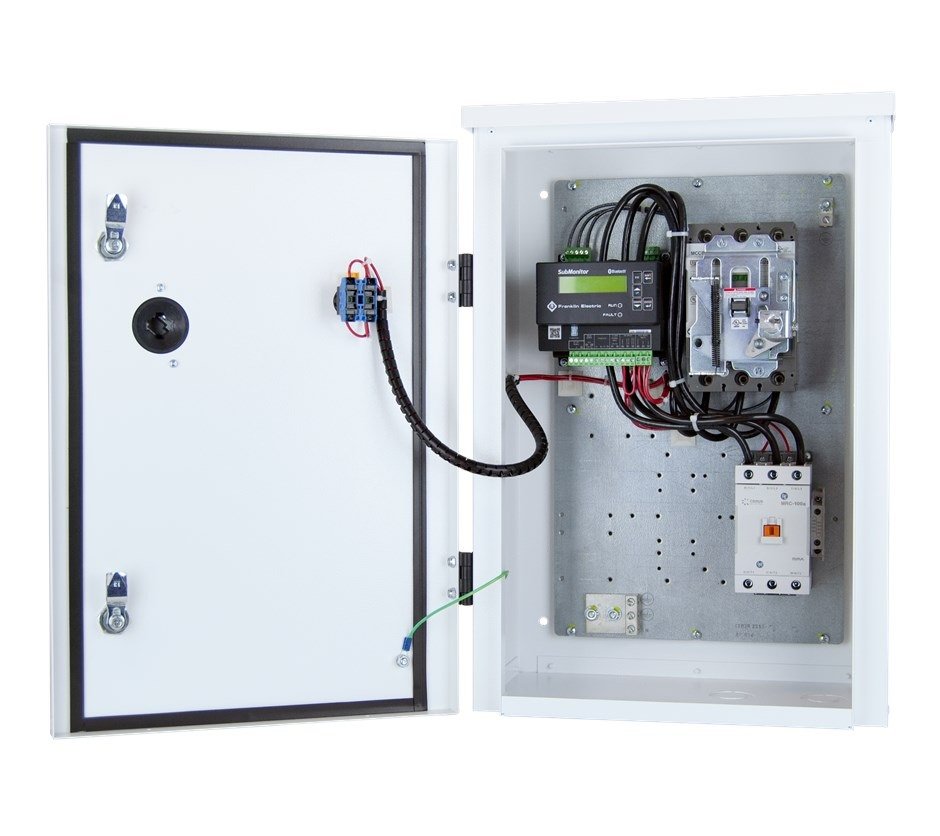 泵电气外壳
泵电气外壳
但是,适合此类区域的设备的设计具有使它们能够承受此类条件的特性。
它们专门用于存放水处理机的保险丝、开关等电气设备。
§ 行业
可以理解的是,无论提供何种服务或产品,你几乎找不到没有电气外壳的工厂。
工厂经常使用各种电气设备来促进生产和提高生产力。
而且,许多活动总是在这样的环境中同时发生。
因此,保护工厂内员工和其他设备的最佳方法是将这些组件封装在机柜中。
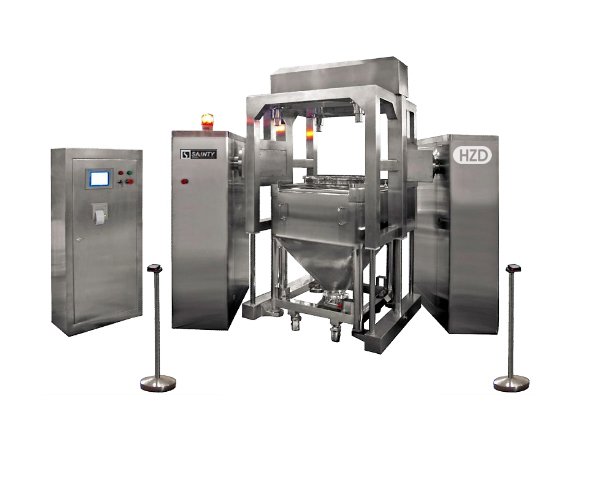
电气外壳 IBC 料箱搅拌机
管理各种电机的运行也变得容易。
嗯,这些是电气外壳的一些典型应用。
但事实是,这些设备几乎存在于所有使用各种电器的领域。
事实上,即使在住宅中,只要它们能够满足其设计的特定用途,您就可以拥有它们。
控制台
电气外壳广泛用于不同的控制台,如振动干燥机, 振动抛光机 等等。
KDMSteel:您最好的工业应用电气外壳制造商
有一个基本方面我还没有在本指南中谈到,如果我不说明的话那将是非常不公平的。
现在,正如您可以从本指南中清楚看到的,电气外壳包含几个元素。
顺便说一句,根据具体的应用和需求做出正确的选择可能会有些令人困惑。
事实上,购买和安装此类设备时获得安心的唯一方法是从可靠的制造商处购买。
KDMSteel 就是寻求此类产品的制造商之一。
他们擅长制造完美无瑕的不锈钢设计外壳,相信我,选择他们,你绝对不会出错。
该公司在该行业已有十多年的历史,专门定制不锈钢电气设备。
我的意思是,这充分表明您已获得最适合自己需求的最佳电气外壳。
因此,为了让您的工作轻松,免去购买这些物品的麻烦,只需向 KDMSteel 下订单即可。
结论
希望本指南能让您大开眼界。
我相信在完整阅读完本文后,您现在可以自信地前往特定的商店并选择最好的电气外壳。
当然,这正是本指南的目的。
至少让您掌握有关该电器的一些基本概念,以便您轻松选择和购买。
但我也承认,有时您可能需要一些您可能不理解的额外信息。
或者,您只是需要进一步了解本指南的主题。

如果是的话,请立即联系我们。
我们的支持人员将随时为您处理问题或疑虑。
产品规格书
规格
应用
您最好的电器外壳供应商
电气外壳,也称为电气箱或电气柜,广泛应用于不同的行业。
通常,电气外壳可分为独立式电气外壳、壁挂式电气外壳、 落地式电气外壳, 模块化电气外壳, 接线盒外壳, 玻璃钢电气外壳、大型电气外壳、带窗口的电气外壳。
它们还可以采用单门或多门设计,以及不同配件的组合。
KDM 在不同类型的电气外壳方面拥有超过 10 年的制造经验,我们拥有超过 20 名工程师为您提供定制设计支持并为您的项目提供最佳解决方案。
KDM 提供各种配件,例如锁、防雨罩、安装脚,能够为您提供数千种组合,您总能找到适合您项目的最佳设计。
所有这些电气外壳都将用于不同的领域来保护您的电气设备,您将在生活中随处看到电气外壳。

通过我们全面的支持、科学的设计、卓越的制造能力,我们不仅可以成为您首要的电气外壳供应商,还可以成为您任何商业和工业应用的合作伙伴。
KDM 可以使用不锈钢、低碳钢、镀锌钢等材料定制您的外壳盒,我们将在 3 天左右设计原型,以便您在批量生产之前确认所有细节。
我们提供多种定制选项,如颜色、材料、安装面板、铰链等,所有细节均基于您的行业规范。只需将您的图纸发送给我们,即可获得即时报价。
我们的交货时间通常为 15 至 30 天,如果您要求对任何电气外壳进行快速报价,我们将在 12 小时内给您报价。
电气外壳:完整常见问题解答指南
- 什么是电气外壳?
- KDM 可以生产哪些类型的电气外壳?
- 什么是壁挂式电气外壳?
- 什么是落地式电气外壳?
- 独立式电气外壳具有哪些特点?
- 电气外壳窗使用什么材料?
- 电气外壳可使用哪些类型的锁和闩锁?
- 什么是接线盒外壳?
- 钢制电气外壳有哪些特点?
- 不锈钢电器外壳如何使用?
- 哪些应用需要通风电气外壳?
- 电气外壳可使用哪些铰链?
- 什么时候需要嵌入式电气外壳?
- 什么时候需要电气外壳具有防风雨功能?
- 什么是模块化电气外壳?
- 您到底有哪些外壳定制选项?
- 镀锌钢外壳如何使用?
- 户外电气柜的特点有哪些?
- 什么是 Nema 外壳?
- 什么是 IP 外壳?
- 外壳的 NEMA 标准是什么?
- 外壳的 IP 标准是什么?
- 对于如何选择电气外壳您有何建议?
- KDM 需要多长时间才能完成我的电气外壳订单?
- KDM 现场有哪些类型的机械?
- KDM Steel 是一家通过 ISO 9001 认证的公司吗?
- KDM Steel 还拥有哪些其他证书?
- KDM 钢制电气外壳有保修吗?
- KDM Steel 如何包装和运输大型电气外壳?
- KDM Steel 会为我们制作外壳图纸吗?
- 如何获得电气外壳的粗略报价?
- 您多久可以向我提供一份生产样品?
- SS316 电气外壳相对于 SS304 外壳有何优势?
- KDM在焊接时如何保证电气外壳表面的光滑度?
- 你们的焊接标准是什么?
- 你们有原材料库存来保证交货吗?
- 你们如何确保产品质量?你们有在线质量控制来检查生产的每个步骤吗?
- KDM 是否接受一件作品开始?
- 电气外壳附带哪些配件?
- 什么是电缆外壳?
- 电气外壳的垫圈是什么?
- 如何设计电气外壳?
- KDM 使用什么软件来制作电气外壳图纸?
- 什么是电气外壳 DIN 导轨?
- 什么样的电气外壳适用于危险区域?
- KDM 是否生产带风扇的电气外壳?
- 电气外壳通常采用哪些颜色?
- 从中国进口电气外壳有哪些好处?
- 独立式、落地式和落地安装式外壳之间有什么区别?
- 什么是绝缘电气外壳?
- 电气外壳市场的未来趋势是什么?
- 电气外壳的主要类型有哪些?
- 什么时候需要在室外电气柜中安装加热器?
- 防风雨电气外壳/接线盒的最佳选择是什么材料?
什么是电气外壳?
电气外壳是一种机柜,用于容纳各种电气和电子元件,并保护它们免受外部危害,如水、灰尘、热和其他外力。
KDM 可以生产哪些类型的电气外壳?
KDM专注于各类碳钢, 镀锌钢以及不锈钢外壳。
在保护电气设备方面,这些材料表现出最佳品质。
什么是壁挂式电气外壳?
一个 壁挂式电气外壳 是一种带有标准或特殊法兰和安装板的柜子,可安装在墙上。

什么是落地式电气外壳?
一个 落地式电气外壳 通常是指用螺母或其他紧固件固定在地板上的电器外壳。
独立式电气外壳具有哪些特点?
这 独立式电气外壳 通常具有平底或稳定的支脚,不需要紧固件固定在地板上。
这意味着这样的外壳可以轻松地从一个地方移动到另一个地方。
电气外壳窗使用什么材料?
的常用材料 电气外壳窗 可以是钢化玻璃,防爆玻璃,亚克力,PC。
上述材料在抵抗外力作用的情况下均具有优良的品质。
电气外壳可使用哪些类型的锁和闩锁?
根据不同的应用,KDM 可以采用不同的锁和闩锁,以便 固定电气外壳,包括夹式闩锁、三点旋转闩锁、四分之一旋转闩锁、夹盖系统、挂锁等。
使用这些机制,您可以保证对内部系统的受限访问。
什么是接线盒外壳?
一个 接线盒外壳 是一个保护柜,使电线连接清洁、安全、工作稳定。
钢制电气外壳有哪些特点?
钢制电气外壳具有防火功能,其结构符合高 IK 标准。
如果您想避免未经授权的访问、高温、水和其他天气影响,这是最安全的选择。
不锈钢电器外壳如何使用?
这 不锈钢电器外壳 可在室内和室外使用,具有良好的防锈性能。

哪些应用需要通风电气外壳?
包含大量电气部件的大型外壳或高功率电气部件的外壳将需要 带风扇的通风设计.
这有助于确保良好的空气流通,以维持这些电气零件的温度和适当的工作条件。
电气外壳可使用哪些铰链?
对于不同的应用, 不同的铰链 将会被KDM选择,例如连续铰链,隐藏铰链,弹簧铰链,不锈钢铰链等。
什么时候需要嵌入式电气外壳?
嵌入式电气外壳是有限空间应用的理想选择,并且可以更好地保护电气部件。
什么时候需要电气外壳具有防风雨功能?
防风雨是电气外壳的一个重要特性,特别是在环境恶劣的情况下,例如在户外使用的情况下。
什么是模块化电气外壳?
模块化电气柜是一种具有通用设计和组件的柜体。
您可以轻松添加您喜欢的额外功能。
您甚至可以将单个电气外壳组合起来,形成大型电气外壳或外壳组。
您到底有哪些外壳定制选项?
KDM 为您提供各种定制功能,例如不同的材料、尺寸、表面处理和各种配件。
镀锌钢外壳如何使用?
镀锌钢外壳通常具有粉末涂层表面。
这样,它比普通碳钢外壳具有更高的防风雨标准。
户外电气柜的特点有哪些?
室外电气外壳通常具有防风雨功能,并具有良好的防锈性能。
它还应具有高 IP 等级,以确保电气部件正常工作。
什么是 Nema 外壳?
Nema 外壳 是由美国国家电气制造商协会根据防水、防尘等性能评定的外壳。
什么是 IP 外壳?
IP 外壳 是具有侵入防护标准等级的外壳,这意味着该机柜具有防水防尘功能。
防水防尘的程度体现在IP等级标准中。
外壳的 NEMA 标准是什么?
NEMA 标准 外壳的等级基于美国国家电气制造商协会的等级,类似于 IEC IP 等级。
它提供了一个标准来显示电气外壳的防水、防尘和防冰等级。
外壳的 IP 标准是什么?
IP标准 指国际防护标志或入侵防护等级。
它通常根据 IEC 标准 60529 或 EN60529 进行测试。
IP标准显示的是电气外壳的防水防尘等级。
对于如何选择电气外壳您有何建议?
首先,您应该考虑电气外壳的使用环境。
根据您未来的需求,您可以选择材料、紧固样式(壁挂式或落地式)和其他设置(如尺寸、锁定选项等)。
KDM 需要多长时间才能完成我的电气外壳订单?
这实际上取决于您最终想要实现的订单数量和外壳类型。
通常大约需要7-20天。
KDM 现场有哪些类型的机械?
KDM 拥有制造电气外壳所需的所有类型的机器,包括数控激光切割机、折弯机、冲压机、橡胶发泡机等。
您可以在这里观看视频,其中展示了 工作流程 在我们的制造基地。
KDM Steel 是一家通过 ISO 9001 认证的公司吗?
是的,KDM Steel 是经过 ISO9001 认证的制造商。
KDM Steel 还拥有哪些其他证书?
除了ISO认证,我们还拥有IP65、IP66、国家发明证书等等。
您可以查看我们的 ISO 证书 访问此页面.
KDM 钢制电气外壳有保修吗?
KDM Steel 为我们所有的外壳提供一年的配件保修。
如果您的产品在一年内出现问题,我们将免费更换。
KDM Steel 如何包装和运输大型电气外壳?
根据不同的货物,我们将使用泡沫、纸箱、托盘或木箱来包装货物。
KDM Steel 拥有长期可靠的合作伙伴来运送我们的货物。
KDM Steel 会为我们制作外壳图纸吗?
是的,完全没问题。我们的设计师可以在 1 个工作日内为您提供 2D 或 3D 图纸。
如何获得电气外壳的粗略报价?
要获得粗略的报价,您只需告诉我们外壳的尺寸、数量和材料。
如果您还想了解运费,请告知我们您的地址信息。
您多久可以向我提供一份生产样品?
我们可以保证您将在订购后 3 天内收到样品。
SS316 电气外壳相对于 SS304 外壳有何优势?
这些钢材类型在外观、化学成分和特性上非常相似。
这两种钢材都非常坚固,并且能提供完美的抗腐蚀和防锈性能。
304不锈钢因其耐腐蚀性能而成为世界上用途最广泛、应用最广泛的奥氏体不锈钢。
304 不锈钢与 316 型相比成本也更便宜,这也是其受欢迎和在世界范围内使用的另一个原因。
316 不锈钢更昂贵,因为它具有更好的耐腐蚀性,尤其是对氯化物和氯化溶液。
这使得在存在盐分暴露问题的情况下,316 不锈钢更加理想。
如果您的应用涉及强腐蚀剂或氯化物,那么 316 不锈钢的额外成本是完全合理的。
KDM在焊接时如何保证电气外壳表面的光滑度?
为了使您的外壳表面更加光滑,我们的工程师在焊接完成后使用抛光机。

你们的焊接标准是什么?
有几种国际焊接标准。
在 KDM,我们使用 GB/T16672-1996 标准(ISO 6947:1993)。
你们有原材料库存来保证交货吗?
是的,我们有库存正常厚度的碳钢板、不锈钢 304 板和不锈钢 316 板,例如 1 毫米、1.5 毫米和 2 毫米。
标准锁和铰链也有库存。
这可确保您获得更短的交货时间。
你们如何确保产品质量?你们有在线质量控制来检查生产的每个步骤吗?
生产前需提供所有图纸供客户批准。
对于每个步骤,我们都会有在线质量控制进行检查,并且成品外壳在发货前将进行 100% 检查。
KDM 是否接受一件作品开始?
是的,我们可以接受单件订单。
此外,我们可以提供一个免费样品以供检查批量订单。
电气外壳附带哪些配件?
答案取决于您要订购的外壳类型及其运行环境的要求。
KDM 可以提供带有遮阳罩、支架、窗户、防雨罩、风扇、锁和其他配件的围栏。
此外,我们始终会添加安装外壳所需的安装元件(例如螺母和其他紧固件)。
什么是电缆外壳?
电缆外壳是一种可用于保护电缆线路免受不同环境影响的盒子。
基本上,这是一个长长的金属柜,覆盖了四面八方的电缆。
电缆盒可用于办公室、工厂和其他技术建筑;它们可以悬挂在天花板上或放在靠近墙壁的地板上。
电气外壳的垫圈是什么?
当需要对外壳进行额外的防尘防水保护时,垫圈是极其必要的。
通常,它们由防风雨闭孔海绵橡胶和硅胶海绵垫片材料制成。
垫圈必须放置在外壳内部可能出现泄漏的地方(接缝、门、窗等)。
如何设计电气外壳?
首先,您必须了解机柜内将放置哪种电气设备。
每个系统对温度、空调、湿度等都有特定的要求。
在我们弄清楚了有关应用程序的所有信息之后,我们可以提出尺寸建议、所需材料和配件的清单。
我们还提供提款服务,以便您可以直观地看到未来的产品。
KDM 使用什么软件来制作电气外壳图纸?
KDM 可以提供 2D 和 3D 图纸,包括 CAD、Solidworks 等。
什么是电气外壳 DIN 导轨?
DIN导轨是电气工程中使用的金属导轨的统称。
根据要求(重量、耐用性、电流),使用镀锌钢或铝进行制造。
DIN 导轨可用于安装电气外壳内的各种模块化设备。
什么样的电气外壳适用于危险区域?
这取决于我们所谈论的危险区域的类型。
根据存在爆炸可能性,危险区域可分为三类:0 区(爆炸性环境长期持续存在或经常出现的区域);1 区(由于修理、维护操作或泄漏,可能偶尔出现爆炸性环境的区域);2 区(正常运行时不太可能出现爆炸性环境,即使出现,也只会持续很短时间的区域)。
因此,在 0 区操作时,您必须选择最防爆的外壳,例如 NEMA 7 型外壳。
在其他情况下,您可以使用具有高 IP 等级的不锈钢外壳。
KDM 是否生产带风扇的电气外壳?
是的,KDM 可以制造带风扇的电气外壳。
我们可以为您设计通风百叶窗,并安装110V或220V的风扇。
电气外壳通常采用哪些颜色?
对于不锈钢外壳,通常不采用其他表面处理。
它是原始的不锈钢颜色。
对于碳钢外壳,我们将进行粉末涂层表面处理。
基本颜色是灰色、白色或米色。
但是,我们也可以根据 RAL 色卡制作其他颜色。
从中国进口电气外壳有哪些好处?
作为中国的专业制造商,KDM 提供高质量且具有成本竞争力的外壳。
KDM 提供所有类型的钢制外壳,为您提供一站式解决方案。
此外,KDM 外壳还可以 IP65 并通过 IP66 认证,满足您的需求。
KDM 可以帮助运送到您的仓库,以节省您的时间。

独立式、落地式和落地安装式外壳之间有什么区别?
独立式电气外壳是最简单的外壳类型,其基本上是一个用作独立外壳的单一整体式机柜。
您可以将其放在地板、架子或其他光滑的表面上。
落地式机柜是一种可以放置在地板上的独立式机柜。
独立式和落地式外壳都不需要用紧固工具安装,因此可以轻松移动。
落地安装外壳是一种必须用螺母或其他紧固件安装在地板上的外壳。
什么是绝缘电气外壳?
KDM 钢制外壳可以隔热,这意味着它们可以对阳光、高温、火灾和其他热力提供额外的保护。
电气外壳市场的未来趋势是什么?
绿色能源的渗透率预计将增加对电气柜的需求,因为它们是确保所生产的绿色能源的安全性和高效性的有效工具。
过去十年来,可再生能源或绿色能源一直是中国关注的重点。
由于清洁能源的技术成本高,以及与电力系统相关的各种问题,清洁能源的引入率仍然较低。
然而,可再生能源创造之路必将在不久的将来促进电气柜市场的增长。
电气外壳的主要类型有哪些?
电气外壳有很多种分类方法:根据使用的材料(碳钢、不锈钢、铝外壳)、根据安装方法(独立式、落地式、壁挂式外壳)、根据遵守的国际标准(NEMA、IP 外壳)、根据操作区域(室内和 户外围栏).
还有不同类型的外壳,例如接线盒或电缆外壳。
在 KDM Steel 目录中,您可以找到适合各种应用需求的所有已知类型的外壳。
什么时候需要在室外电气柜中安装加热器?
不仅过热会影响电气设备的运行。
寒冷月份的极低温度也可能会影响性能。
例如,橱柜内部可能会形成冷凝水,水可能会进入内部系统。
在这种情况下,您可以使用加热系统将温度保持在可接受的操作范围内。
防风雨电气外壳/接线盒的最佳选择是什么材料?
在制造过程中 防风雨电气外壳此外,KDM Steel 工程师使用不同类型的钢材,例如碳钢和不锈钢。
但是,对于防风雨柜,必须使用额外的装置,例如绝缘垫圈和防雨帽。




